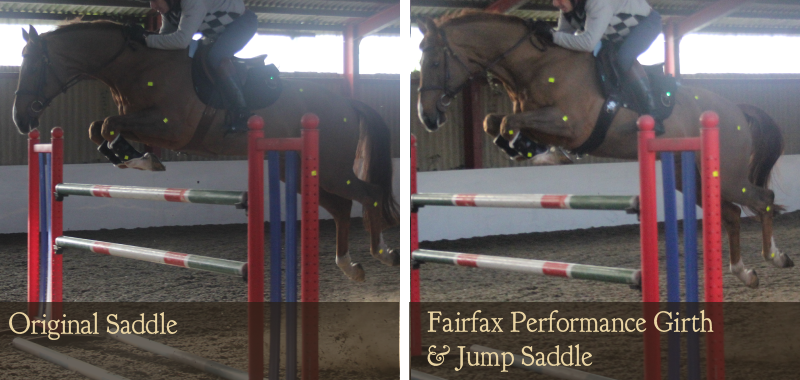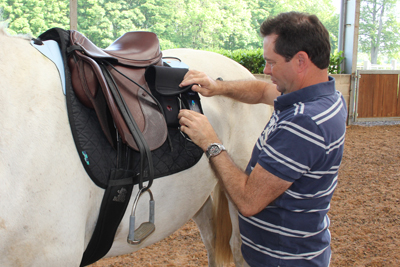At Woolcroft, we are not only passionate about fitting saddles to horses correctly in order to prioritise horse welfare and improve performance, but also to advance the current research field to enable science to benefit the equestrian industry. This not only benefits you as a rider, (and hopefully your competition record), but also your horse's quality of life. Lets face it, we all want the very best for our horse.
Mark, who operates Pliance testing (measuring how saddles distribute pressure across a horse's back) for the BEF and the Society of Master Saddlers often works with Russell Guire of Centaur Biomechanics. Russell's gait analysis camera records 300 frames a second - approximately 25 times faster than the human eye - and these images are then fed through a computer programme that processes them, captures the data and provides information on joint and limb angles.
Vanessa Farfax of Fairfax Saddles Ltd uses Pliance (SMS). Simultaneous testing using Pliance pressure mapping and Centaur Biomechanics gait analysis gives Vanessa a unique cause and effect insight enabling her to accurately assess and develop her products from a horse's point of view. "Using technological testing when I am developing saddles enables the horse to tell me exactly how every design change actually impacts on pressure and freedom of movement," Vanessa explains. "It removes all subjectivity and any improvement in performance can actually be recorded and measured. When I am testing a design alteration I want to know exactly what effect it has on limb extension and joint flexion".
Di specialises in rein tension and has conducted a large volume of exciting analysis over the last year on a wide range of horses, including our three year olds that we have recently backed.Di is currently working with Fairfax and their bridle clinics using the Rein Gauges to show the improvements in the horses way of going. Christina also has a large research background after studying psychology at university for four years and producing a very sucessful dissertation investigating cortisol levels and the effect of stress and anxiety on dressage rider's performance in both training and competition.
We list our previous and current research information below. Please see the Fairfax website for more in depth analysis details: http://www.fairfaxsaddles.co.uk/testing and all details of research carried out on behalf of the SMS are available on the SMS website.

The Fairfax Performance Bridle - 2015
This revolutionary bridle (modelled by our very own stallion) design is based on two years of scientific testing to establish exactly where the pressure peaks are under a bridle and how they affect the horse in motion. Using two bespoke pressure mats, Mark used the SMS/BEF Pliance system to analyse the pressure under different designs of headpiece and noseband. This data was then used to design a bridle that significantly reduces pressure in the six key zones where peak pressures were recorded.
Gait analysis was carried out by Russell Guire of Centaur Biomechanics to establish how a reduction in pressure affects the horse’s freedom of movement. Horses wearing the Fairfax Performance Bridle, recorded significantly greater hock flexion, knee flexion and forelimb protraction. Riders could feel this improvement in movement and also a greater harmony with their horse.
We are in the process of submitting a scientific paper on the findings of our bridle research and we will provide full details as soon as this is permissible. Watch the video at https://youtu.be/0rvru6KNoYM
The Performance Girth
Kept secret prior to the London 2012 Olympics in order to gain a competitive advantage, the performance girth was the only girth to have been tested during its development in conjunction with the BEF World Class Programme. Mark used pliance pressure mapping technology to identify the exact location of high-pressure zones under the girth. The readings were then used by Vanessa to design the girth, which is proven to reduce peak pressures by as much as 82%.

- Fairfax's video on the development of the girth: http://youtu.be/ofOeowsYmoU.
- Horse & Hounds Article on the girth: http://www.fairfaxsaddles.co.uk/images/fairfax/pdfs/P058-060_HAH_AUG30.pdf
The Fairfax Dressage Saddle
Henriette Andersen rode four of her Grand Prix horses in their original saddle and girth combination for simultaneous pressure mapping and gait anlaysis testing. These readings were used to gather benchmark data.
Henriette then repeated the simultaneous testing procedure using the new Fairfax Dressage Monoflap with the Performance Panel and Performance Girth. Watch the video at http://youtu.be/09Qmr6VIRto. We recorded the following in all four of the horses used during testing:

- Reduced peak pressures
- Lower maximum forces
- Greater fore and hind limb extensions
- Increased knee and hock flexion
- Improved gait symmetry
The Fairfax Jump Saddle
The images below show how the performance panel in Fairfax saddles allows the horse to use their shoulder more and flex their knees more. Notice also the position of his head and neck – the horse isn’t having to put as much effort into clearing the fence so his head and neck are not stretched as low. We have now completed trials with 18 international showjumping horses and the results have shown a significant improvement in every horse in the following areas:

- Reduced under saddle pressure
- Increased contact area
- Shoulder flexion over the fence
- Knee flexion over the fence
Other Research
- A pilot study looking at the effect that current mounting techniques has on the equine back, Russell Guire, Mark Fisher, Liz Leggate and Society of Master Saddlers, Centaur Training and Livery Centre, Warwickshire (Published Your Horse Magazine 2010)
- The effect of a girth versus the Fairfax Performance Girth has on equine movement. Russell Guire, Team GBR and Fairfax Saddles. (See Horse and Hound article "Team GB Secret Weapon") Girth Paper
- The effect that saddle slippage in sound horses has on equine movement and rider position (current)
- The effect that x saddle has on equine movement and jump (current)
- The effect of rein tension on horses when turning, jumping and in straight lines (current)



